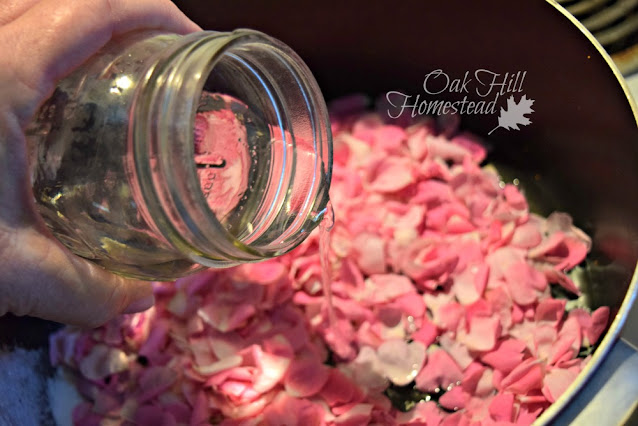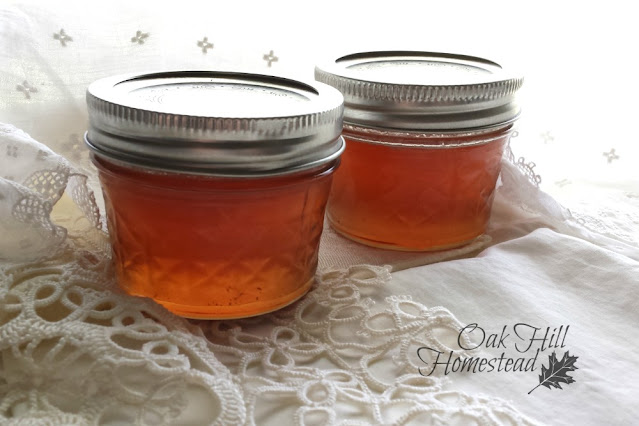Roses are beautiful and have such a delightful scent, but did you know the petals are edible? These step-by-step instructions will help you turn fragrant rose petals into a delightful spread for your morning toast or your afternoon tea time.
Learn how to make rose jelly from scratch with this delicious rose petal jelly recipe.
Rose petal jelly recipe
Have you ever made rose petal jelly or syrup? It's so simple to make from wild rose petals or from the roses in your own yard.
Here's how to forage for wild rose petals or use the petals from your own rose bushes, which plants to avoid, and how to make this sweet old-fashioned jelly.
How to forage for rose petals
I've wanted to make rose petal jelly for several years, but for one reason or another I never managed to hike out to the wild rosebush patch to forage for the petals.
But one weekend I finally resolved that I would walk out to our little thicket of wild roses, gather enough rose petals and make a batch of this sweet, old-fashioned jelly.
The Chief insisted I take a "snake stick" so I could flush out any reptiles, but all I saw was a scared bunny that scampered off at the sight of me.
How to forage for rose petals
Wild roses grow all along the roads here, but please don't use these flowers (or any other plants) that grow on the roadside.
Emissions from car exhaust systems, rain run-off containing toxic chemicals, and lead in the soil have ruined these plants for anything other than their visual beauty.
Also be sure to use flowers from plants that haven't been treated with herbicides or pesticides. I know the plants on my own land haven't been sprayed and they are far from the road, so they are safe to use in this recipe.
This wild rose thicket is huge this year because of all the rain we've had. I've never seen so many roses. These are little six-petaled pink blossoms, not the domesticated roses we grow in our yards.
But you can use rose petals from the cultivated rosebushes in your yard, if you wish. Again, don't use flowers if you've sprayed pesticides or other chemicals.
The summer air was buzzing with the noise of many bees on the day I walked out to the rose thicket. I'm so thankful for the wild pollinators.
I felt a bit bad about taking the flowers with so many bees around, but I left the centers of the flowers, where the pollen is.
Ethical, responsible foraging guidelines recommend harvesting less than 30% of a wild plant, leaving the rest for birds, wildlife and insects.
There were many, many flowers and buds left when I had filled my basket and walked back home.
Back in the house I sifted through the petals and pulled out a few small leaves and an ant.
I'd gathered four cups of leaves, lightly packed in the measuring cup. That's enough for two batches of rose petal jelly.
I'd saved a carton of squat, half-pint jars to use for this jelly. I washed the jars and set them aside while I made the jelly.
What you'll need to make rose petal jelly
To make rose petal jelly, you'll need:
- 2 cups of fresh rose petals
- 2 cups filtered water
- 2 cups of sugar
- juice of one lemon (about 3 tablespoons)
- 1 box of pectin
How to make rose petal jelly
To begin, add the rose petals and filtered water to a saucepan.
Turn on the heat and simmer gently for ten minutes. As it simmers, the color of the petals washes out and they get very pale.
After simmering for ten minutes, pour it all through a strainer to remove the spent rose petals. Return the juice to the saucepan. The rose petals can go on your compost pile.
Add most of the sugar to the liquid in the saucepan, reserving about 1/4 cup of the sugar. Stir the juice so the sugar dissolves.
Next, add the lemon juice. Interestingly, the color of the juice changes when you do this. Let the lemon-and-rose-water simmer for another ten minutes.
Mix the reserved sugar with the powdered pectin, combining it well, and add it all to the pot.
Simmer the liquid for another 20 minutes, then ladle into sterilized jars. I use these little 4 oz canning jars.
Add the lids and rings to the jars.
How to water-bath can rose petal jelly
You can store your jars of jelly in the refrigerator for up to six months, or you can water-bath can it to give it a longer shelf life with no refrigeration needed. You'll find directions on canning jelly in this post.
This recipe makes about six 4-ounce jars. You can find these cute little canning jars here.
What if you don't have access to wild roses?
You don't need to be limited to wild rose petals to make this delicate, delicious jelly! You can use roses from your own yard, as long as you haven't used herbicides or pesticides on or near them.
Roses from a florist should not be used, because you have no idea whether or not they have been raised organically (and chances are, they were not!).
More flower jellies you can make
Did you know that roses aren't the only flowers you can turn into jelly? You might want to try these as well:
- Wild violet jelly
- Lilac syrup
- Forsythia jelly
- Dandelion jelly
- And for more uses for rose petals, such as teas and other drinks, see this article from Starwest Botanicals.
How marvelous will this rose petal jelly be spooned onto hot, homemade biscuits in the middle of winter? Or spread on dinner rolls or toasted English muffins? I don't think I'll wait until winter to find out.






















